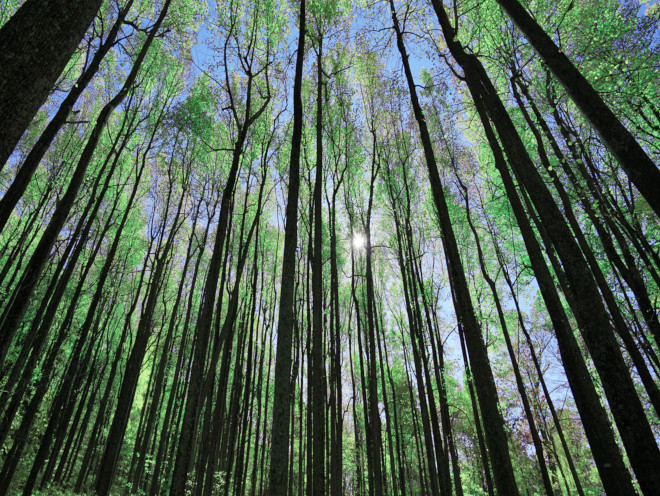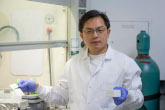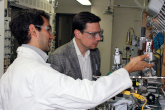
The Blavatnik Family Foundation and the New York Academy of Sciences recently announced 31 finalists for the 2019 National Awards in chemistry, physical sciences & engineering, and life sciences. This year, multiple finalists are recognized for their breakthrough research addressing today’s most pressing sustainability issues.
Here, three finalists discuss how their leading research could result in more wood-powered energy, cleaner chemicals and the preservation of penguins in Antarctica.
 Dr. Heather Lynch with an Adelie penguin at Petermann Island in 2006
Dr. Heather Lynch with an Adelie penguin at Petermann Island in 2006Dr. Heather Lynch, Associate Professor, Stony Brook University is a finalist for using satellite imagery, field work, and advanced mathematical modeling and data to detect population declines predictive of penguin colony collapse.
As a graduate student at Harvard, Heather Lynch made a bold decision. After spending her entire academic career in pursuit of a PhD in experimental physics, she requested a transfer to the biology department – a move that had never been done before.
While physics was enriching and a great challenge, Lynch became increasingly interested in environmental issues and she wanted to become a part of the solution.
“I saw an opportunity to apply my training in quantitative methods to ecology and conservation biology,” she said. “I continue to be interested in how we can overlap the research methods of different scientific disciplines.”
Lynch’s transfer request was approved, and she completed all the requirements for a PhD in Organismic and Evolutionary Biology in two and half years.
Her first major work focused on insect outbreaks and forest fires in places like Yellowstone National Park. That led her to a post-doctorate fellowship where working with a nonprofit she managed an unusual census data project - of penguins. The topic has been the focus of her research lab ever since.
“For the last 15 years, I have tried to incorporate the best available research methods and technology to understand seabird populations in the Antarctic,” she said. “I am particularly interested in how penguin populations are impacted by climate change, the fishing industry, and tourism.”
The study of penguins has mostly relied on field surveys, and much research is limited to studying one penguin colony at a time. But Lynch is an early adopter of incorporating satellite imagery to study how the entire Antarctic penguin population is impacted by changes in climate and the increased presence of humans on the continent.
“We have more access to satellite technology than ever before, and we are still figuring out how much new research we can explore with the technology,” she said. “In 10 years, I bet we will look back and wonder how we were ever able to study ecology without this crucial technology.”
Now, Lynch is as much a computer scientist as an ecologist. Half of her academic appointment at Stony Brook is at the Institute for Advanced Computational Science.
“I am always thinking about what information do policymakers need to preserve the Antarctic and protect the organisms living on it,” Lynch said. “By using satellite technology, artificial intelligence, and other tools – we can provide more accurate information at a faster rate than ever before.”
On being an Award finalist, Lynch said: “I am happy to see ecology being recognized. There are so many researchers in the field conducting important work, and I hope more of their work is recognized in the future.”
 Dr. Liangbing Hu in his lab at University of Maryland
Dr. Liangbing Hu in his lab at University of Maryland Dr. Liangbing Hu, Assistant Professor, University of Maryland is a finalist for exploring the use of wood-derived nanocellulose as a solution to the sustainability challenges in energy, water and the environment.
Human evolution has been closely tied to wood for food, fuel and shelter. But in the last century, there has been a greater reliance on concrete, steel, aluminum and brick building materials, which exponentially increases fossil fuel consumption and global carbon dioxide emissions.
Liangbing Hu is trying to do his part to solve that problem through groundbreaking research.
Early in his academic career, Hu worked with Professor George Gruner at UCLA on nanoelectronics with carbon nanotubes. At that time, Hu never thought he would get into wood research. But during a three-year period at a nanotechnology company in Silicon Valley, he recognized the immense power technology can have to help solve some of the most serious problems that we face today.
“During my post-doctoral research, and for some time after, I have been involved in studying and applying nanotechnology to wood as a method to create more sustainable and bio-degradable products,” Hu said.
Since 2011, he has been investigating the use of wood-based materials for a range of emerging technologies to help drive sustainability efforts. Some of his work has focused on creating lightweight structural materials, building systems for energy storage and conversion, environmental remediation, green electronics, and energy-efficient buildings.
Hu and his team have invented a range of emerging wood nanotechnologies, including a transparent wood, low cost wood batteries, exceptionally strong wood, super thermal insulating wood, and a wood-based water purifier.
“In U.S., about 40 percent of our energy is consumed by buildings, which is greater than any other industry or transportation,” he said.
“Cost-effective and efficient energy can substantially lower our carbon footprint and at the same time provide more uniform building temperatures.”
When asked what sustainability means to him, Hu said, “Sustainability for me as a human being means the same as for everyone else: the ability to exist constantly and to maintain change in a balanced environment.”
“For me as a materials scientist, sustainability means the use of natural materials in the continued development of modern society. Once used, these materials can be fully recyclable or biodegradable and cause no negative impact.”
 Dr. Ive Hermans in his lab at University of Wisconsin-Madison
Dr. Ive Hermans in his lab at University of Wisconsin-MadisonDr. Ive Hermans, Professor, University of Wisconsin-Madison is a finalist for leading breakthrough discoveries in chemistry that help to reduce our environmental footprint.
Being the first in the family to go to college was a huge accomplishment for Ive Hermans. He wanted to make his parents proud and at the same time work towards creating a positive impact in the world. The only way he knew to do this was through his work in chemistry.
He completed his PhD from KU Leuven in Belgium and began his research work in sustainable chemistry. A few years later, he had the opportunity to come to the U.S., where he focused his work on finding solutions to minimize greenhouse gasses while creating more sustainable consumer products.
Hermans strives to design more energy efficient and less wasteful processes for chemical resources that are used in products and services.
“Much of my research involves designing sustainable chemical reactions that generate less waste, consume less energy, or produce fewer greenhouse gas emissions, while still meeting consumer demands for the everyday products that rely on these reactions,” Hermans said.
Among his most significant achievements is the discovery of a more sustainable method for the synthesis of C2-C4 alkenes from natural gas, as compared to traditional oil-based technologies. C2-C4 alkenes are some of the most important chemical building blocks and are integral for the synthesis of value-added chemicals found in materials that help to create products that define our standard of living.
Hermans is working towards developing cleaner processes that use biomass or natural gas, moving away from energy-consuming oil-based technologies.
“We develop materials that can selectively speed up chemical reactions that lead to desired products while avoiding the formation of undesired by-products like the greenhouse gas CO2.”
Hermans and his team recently began working on the chemical recycling of plastic waste back into building-block molecules, closing the lifecycle.
Plastic waste has adverse effects on the environment and the entrance of micro- and nano-plastics is increasingly apparent in our food chain.
“Chemical recycling poses tremendous challenges, but students are very excited to work towards the goal of sustainability because as chemists we have a responsibility to use our understanding of the molecular world to design new pathways that can make a difference for society,” he said.